In today’s competitive mobile application market, gamification is a way to increase engagement and attract more users to the app. In case you wonder how it’s the right time to turn to a definition.
Gamification is the process of adding gaming mechanics to regular apps. They tend to create competitiveness, a sense of progress, and engagement for the user. In this article, we will dive deeper into the topic, outlining what gamification is and what benefits it provides. Moreover, we will look at many examples to speak not only on behalf of our expertise but relying on real examples. Let’s get to it.
Gamification definition
So, gamification, as already mentioned, is the process of adding game mechanics to the regular usage processes. On average, mobile users spend more than three hours using mobile devices daily. More interestingly, 11% of that time is spent on mobile games. Needless to say, mobile games have always held the top charts of all downloads in any app store. What does it tell us?
It means that the gaming aspect has always been popular, and implementing its elements in regular apps is a winning decision. Basically, this gamification has always been in our daily lives and is a mere psychological effect.
For instance, teachers reward children with stickers and divide students into groups to create competitiveness. World-known brands organize contests, putting their customers in leaderboards and inducing them to purchase more and increase their winning chances. Clearly, gamification is a commonplace practice in many aspects of our lives.
In apps, though, gamification is no different. It still encourages users to spend more time, take more actions, and invest in the app. However, it is implemented differently. Moreover, gamification became such a hot topic that mobile app development experts started building strategies around it. Let’s talk about it next.
Gamification as an effective strategy for mobile apps
Essentially, gamification is a wide topic. In other words, there are many gaming mechanics that apps can leverage. Keep in mind that to adopt the strategy, product discovery is an essential step to determine which gamified elements suit the app.
Now, let’s dive deeper into the main mechanics that fit non-gaming apps the most.
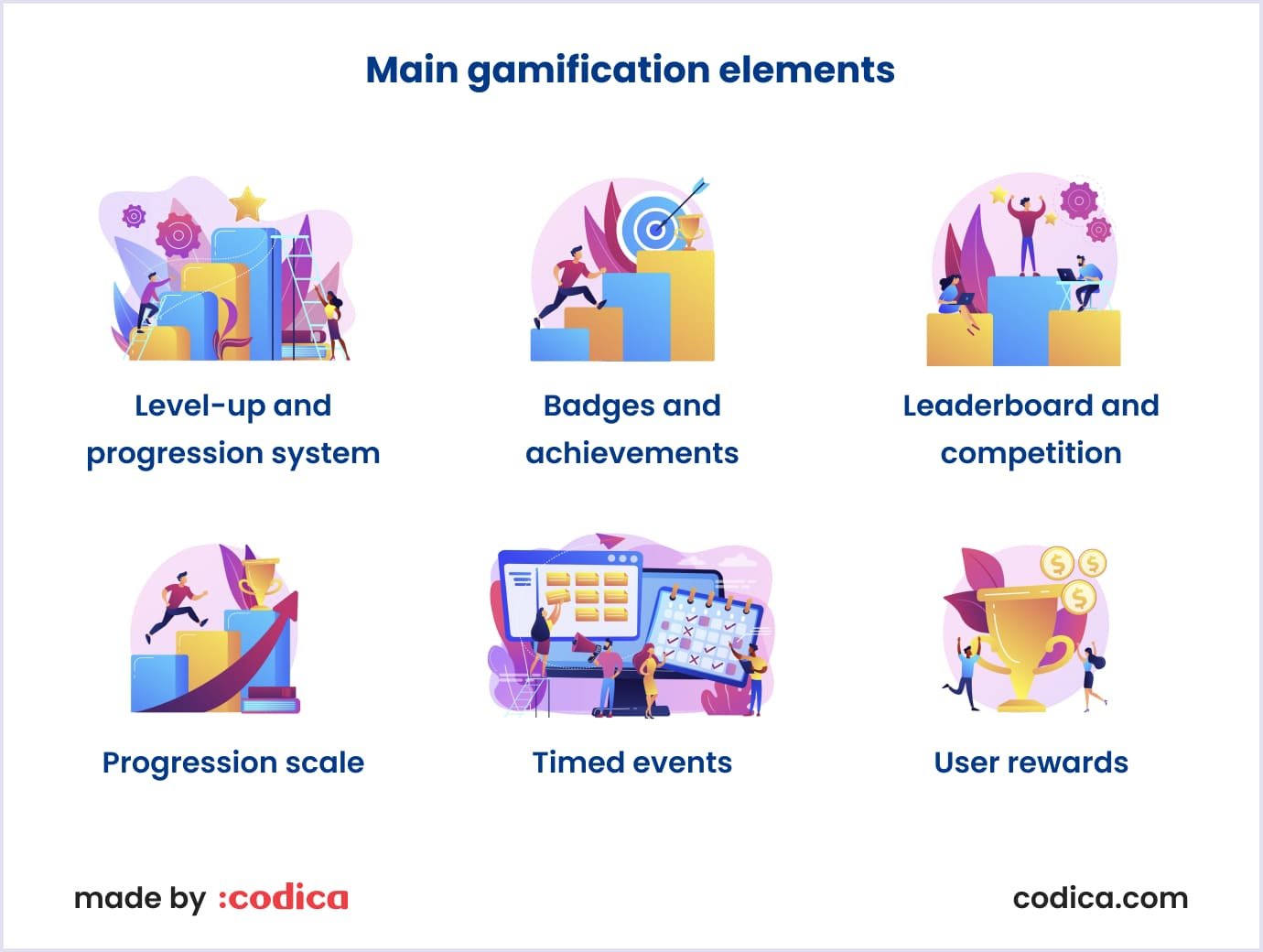
Level-up and progression system
This is a widely popular mechanic commonly met in learning apps and in others where progression is appropriate. Normally, this functionality is quite simple.
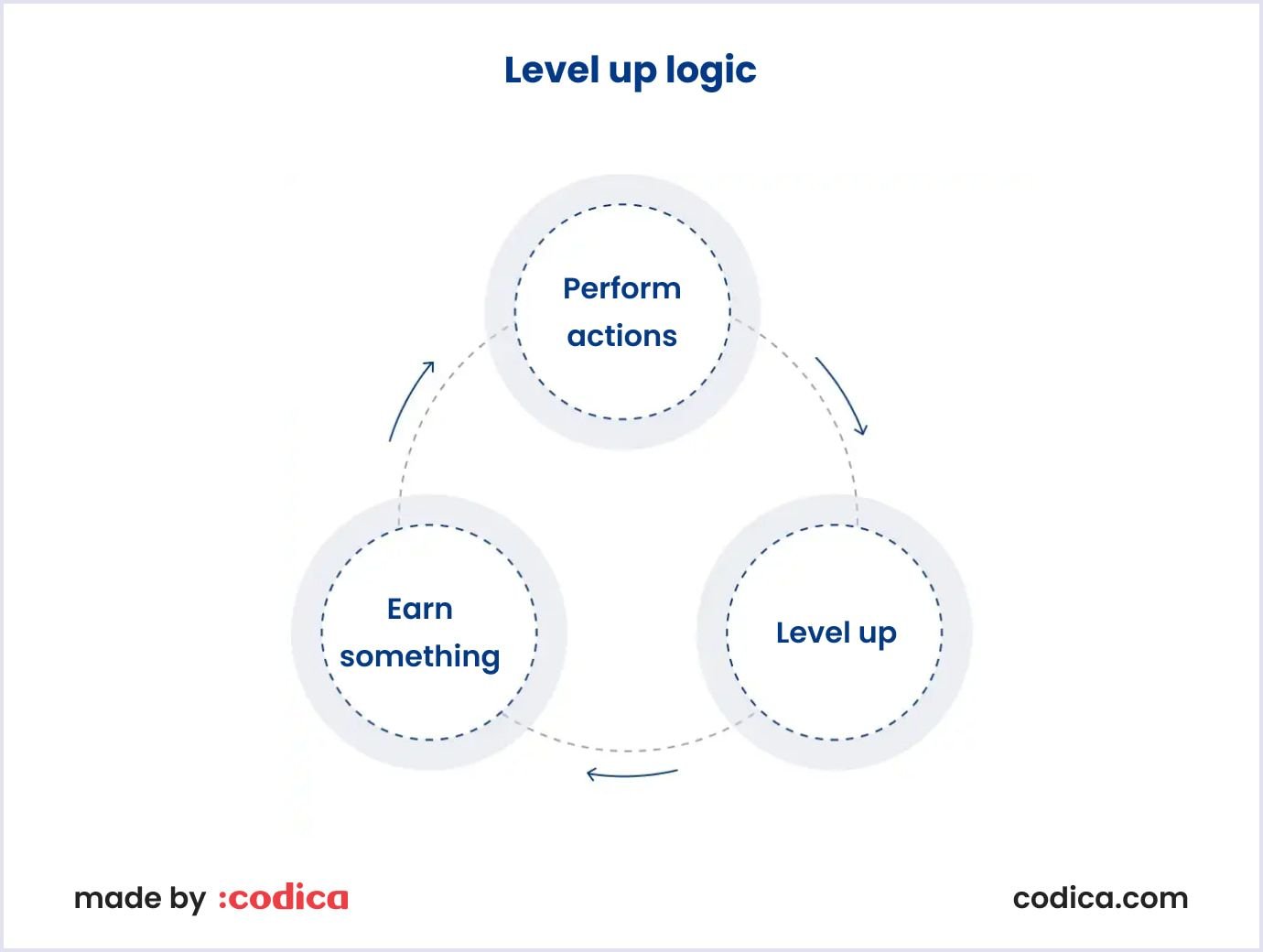
When users perform actions and progress through the app, they may see a progression scale and increase their in-app level. Thus, they can increase it by performing regular workflow tasks the app provides.

With each new level, the app can grant people many things to keep them engaged. For example, some apps may provide:
- Visual additions. They include new fonts, new color schemes, wallpapers, etc.
- Stylish additions. They may include new avatars, stickers, badges, and other cosmetic items.
- More options. Once users advance on the levels ladder, they can open new functionality, i.e., advanced features.
There’s a myriad of things that can be granted in exchange for users’ leveling up. Accordingly, this strategy is quite effective in engaging the audience and making them love your application.
Badges and achievements
These attributes are quite common in many apps today. They appeal to basic human psychology, where people are excited to earn a title or a badge in exchange for their effort or time. These attributes are quite popular in apps with a progression scale. They are also commonly combined with the level-up system and leaderboards we will cover next.
Badges and achievements can also serve as memories. For instance, when a user completes 10 consecutive pieces of training in a fitness app or completes all weekly tasks in a language learning app. Hence, it feels good to remember personal achievements, and badges do a great job of saving this memory.
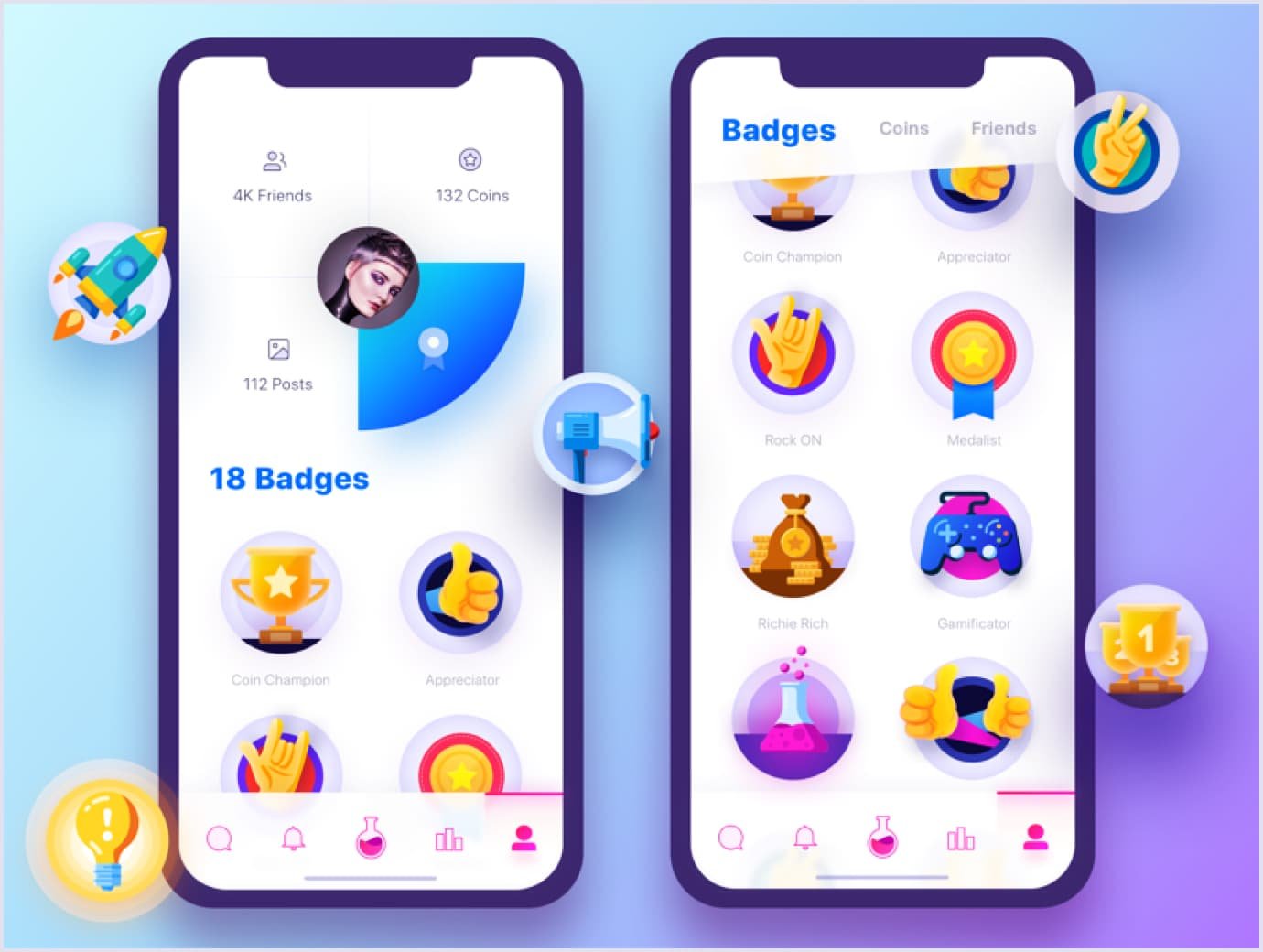
Leaderboard and competition
Again, speaking of competitiveness, leaderboards are a great stimulus for people to engage with the app. They are presented in the form of a table or list where other users get enlisted as they progress in the app.

Although leaderboards are more natural in games, regular apps also utilize them. For instance, you can see leaderboards in fitness apps where people compete in the number of miles they run or any other app where there’s room to compare users’ performances.
Timed events
Time-limited events are yet another interesting gamification feature that can be met in regular apps. In games, it is used to show players that some quests or tasks are tied to the day or that the chance to purchase the item will end soon.
In regular apps, for example, developers can add countdown timers for items on sale or challenge users to take action to keep up with the plan. One of the coolest implementations of timed events can be met in BeReal – a social media app created to share real photos without filters, posing, etc.
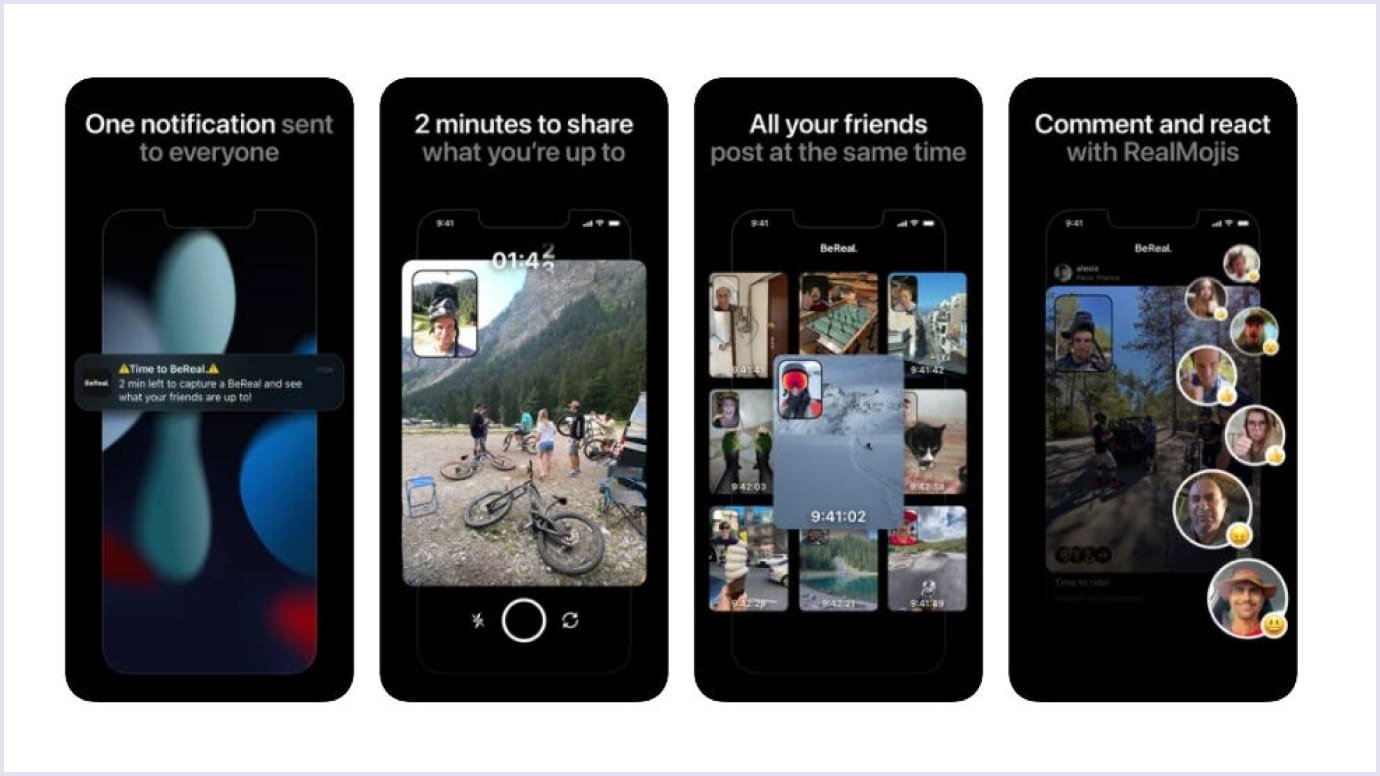
To fulfill the idea of the app, randomly during the day, users receive a notification to take a picture of what they are up to at the moment. This event is limited in time and lasts only 2 minutes.
If users make it in time, they can post more and view others’ previous day's posts. If they can’t, they are marked as late and cannot see others’ photos until after they’ve posted.
User rewards
This gamification element is recognizable by anyone. The range of different rewards users can receive is extremely wide. Same as with progression, users can get style additions to customize their avatar. In banking or shopping apps, people can get cashback or personalized discounts.
For instance, companies often add gambling aspects to their apps, allowing users to spin the wheel and win a discount. In messaging apps like Telegram, people can get stickers which can be used in chats.
In other words, there’s a myriad of things users can receive as a reward. Moreover, these things can be tailored to the app’s specific purpose, supplementing it and engaging users even more.

Benefits of gamification in apps
Now that the gamification term is clear and the most popular methods are outlined, let’s discuss the benefits of implementing them.
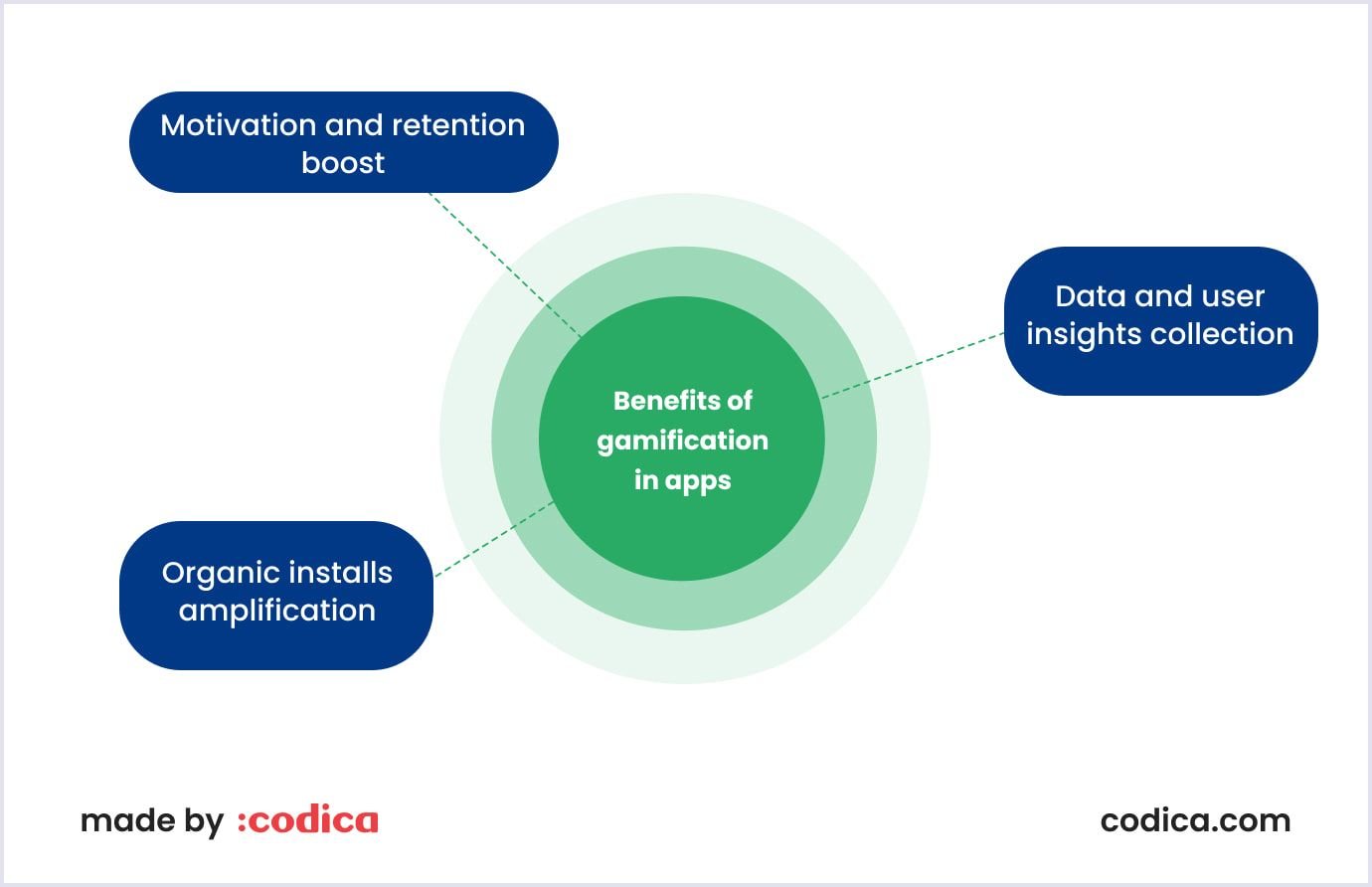
Gamification fosters motivation and boosts retention. The gamified design effectively incentivizes users to remain actively engaged for extended periods. This, in turn, positively impacts retention rates and reduces churn. By integrating game-like elements, you create a sense of motivation and progression that keeps users hooked and eager to continue using your app.
Secondly, it allows you to collect data and user insights. Accordingly, developers can collect valuable user behavior and preferences. By tracking user interactions with game elements, developers can analyze usage patterns and see trends. Consequently, they can make data-driven decisions to improve the app's performance and bring the user experience even higher.
Lastly, it amplifies organic installs. For instance, gamification elements in app design enhance its appeal, making it more engaging and satisfying for users. This heightened user experience prompts them to share the app with friends, resulting in organic installs. For example, a bank app with spending achievements can enable users to show off their achievements to friends or on social media. This way, the app attracts more organic downloads, allowing people to use it and celebrate their accomplishments with their social circle.
Examples of apps using gamification
Now, let’s shift attention from the theory to the gamification examples in apps. With gamification, it is always a good idea to analyze how it affects the app’s overall performance, downloads, and user satisfaction. Speaking of the examples, we divided them into categories.
Gamification in learning apps
Nowadays, studying is the key to success, and gamification in education apps is vital and often seems integral. All such apps require effort from users, they must feel motivated to keep up with the rhythm of the app. Hence, gamification is a great bridge between users’ interest and learning something new. Here are some good app examples that utilize it.
Mimo
It is an app created to simplify the code-learning process. With Mimo, users can choose different programming languages, such as Python, JavaScript, HTML, and SQL, or choose an entire web development kit.
Then, lessons are taught through different tests, allowing users to learn the material in different forms. With the help of catchy and friendly design and gamification features, the app feels comfortable, beginner-friendly, and quite engaging.
Speaking of gamification, it has several aspects mentioned earlier. For instance, it has badges users get for completing lessons and a progression system that counts consecutive days users learn programming.

Duolingo
There’s literally no person who hasn’t heard of e-learning titans like Udemy, Coursera, or Duolingo. The latter is the subject matter now. Duolingo is a language-learning app that offers more than a hundred courses and over 40 languages to choose from.
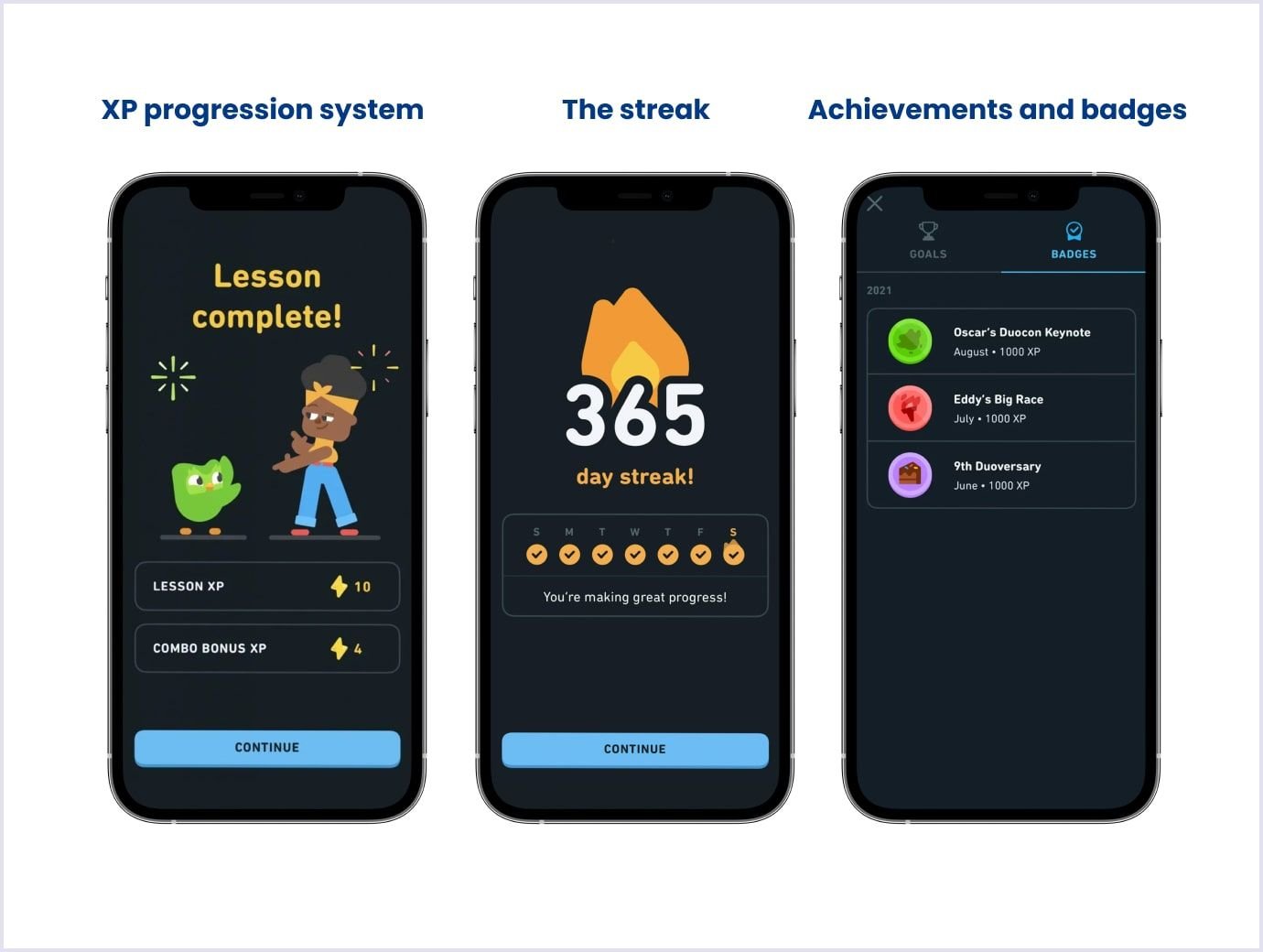
Fun, gaming aspects, and simplicity made this app catapult to the top of learning apps, and it still holds the title of one of the best. Now, what does it offer in terms of gamification implementation?
- It has a progression and level-up system based on XP (experience points). The more users learn, the higher their level is. Moreover, they receive in-app currency in exchange for their progression. With it, users can purchase so-called power-ups to boost their XP gain and freeze the streak if they cannot complete the daily goal but don’t want to lose it.
- “The streak” system is basically the day counter. It marks the days when users meet their daily learning goals. The longer users hold the streak, the more badges or currency they gain. Also, it is extremely useful in terms of boosting the motivation.
- Duolingo traditionally has achievements and badges. Users can gain them for following the streak and for finishing certain courses.

Gamification in healthcare and productivity apps
To simplify the daily routine and self-care tasks, people utilize numerous apps. Healthcare apps help us remember to take pills, drink enough water, and so on.
Productivity apps speak for themselves. They help us stay focused, avoid distractions, and simply get things done.
But, to make such apps effective, developers often enhance them with gamification elements. These elements, in turn, create a motivated and challenging environment, inspiring people to take action. Let’s take a look at two such apps.
Waterllama
Speaking of gamification in health apps, let’s take a look at a Ukrainian startup dedicated to water consumption tracking. With a lovely UI (user interface) design, this app is more than engaging and motivating users to keep up with their water drinking plan and build new habits to track it.
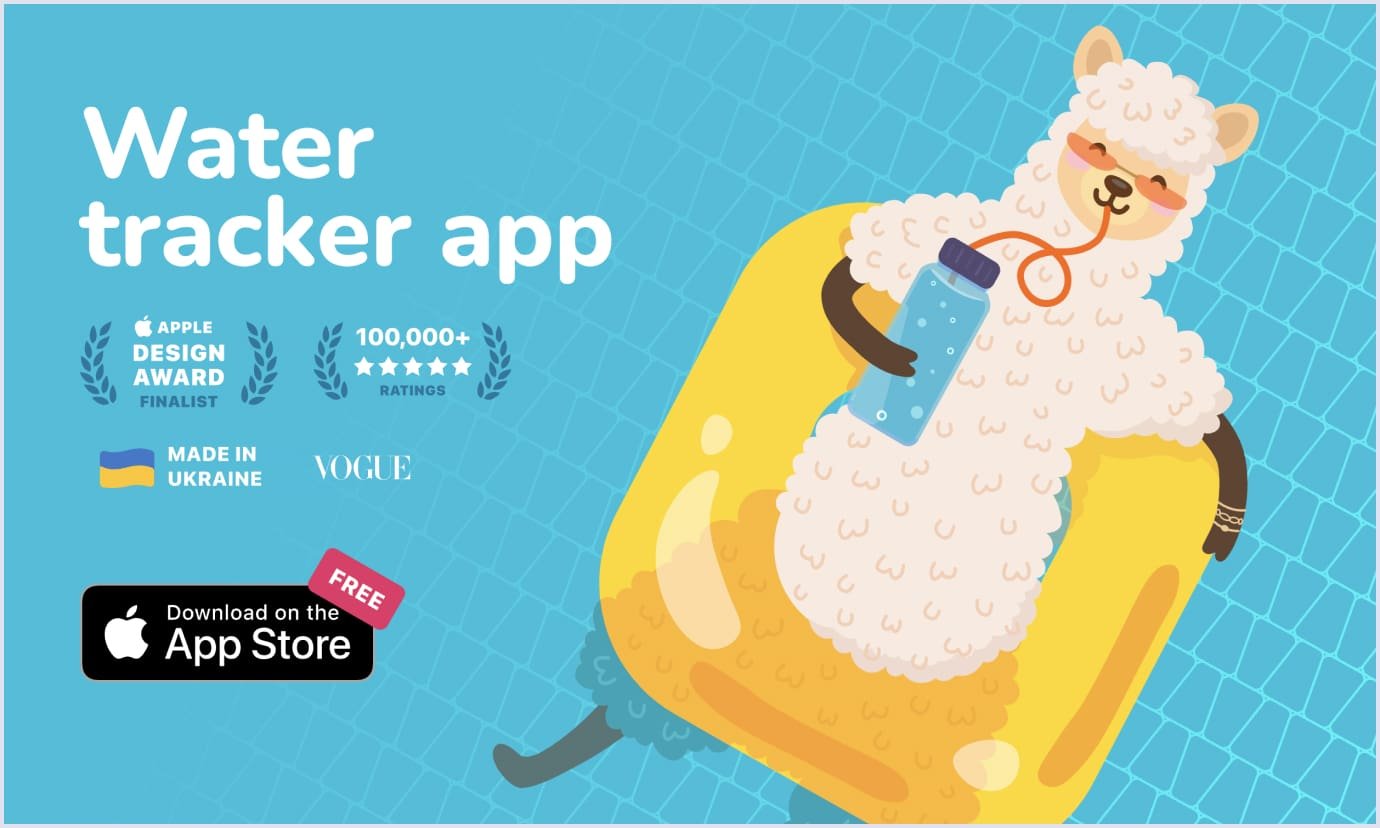
In terms of gamification, the app poses several attention-worthy aspects. First of all, it has many unique and motivational challenges. Some of them advocate sobriety, and some help to overcome coffee addiction.
Secondly, Waterllama has dozens of avatars or characters users can win. They pose a stylish addition to your daily app usage. Moreover, they possess a motivational aspect, as along with keeping up with drinking habits, users get motivated to earn those characters as a bonus.
Lastly, Waterllama also has a progression scale or a streak system, which is quite similar to what you can see in the Duolingo app. It allows users to see their water intake history and plan new goals.
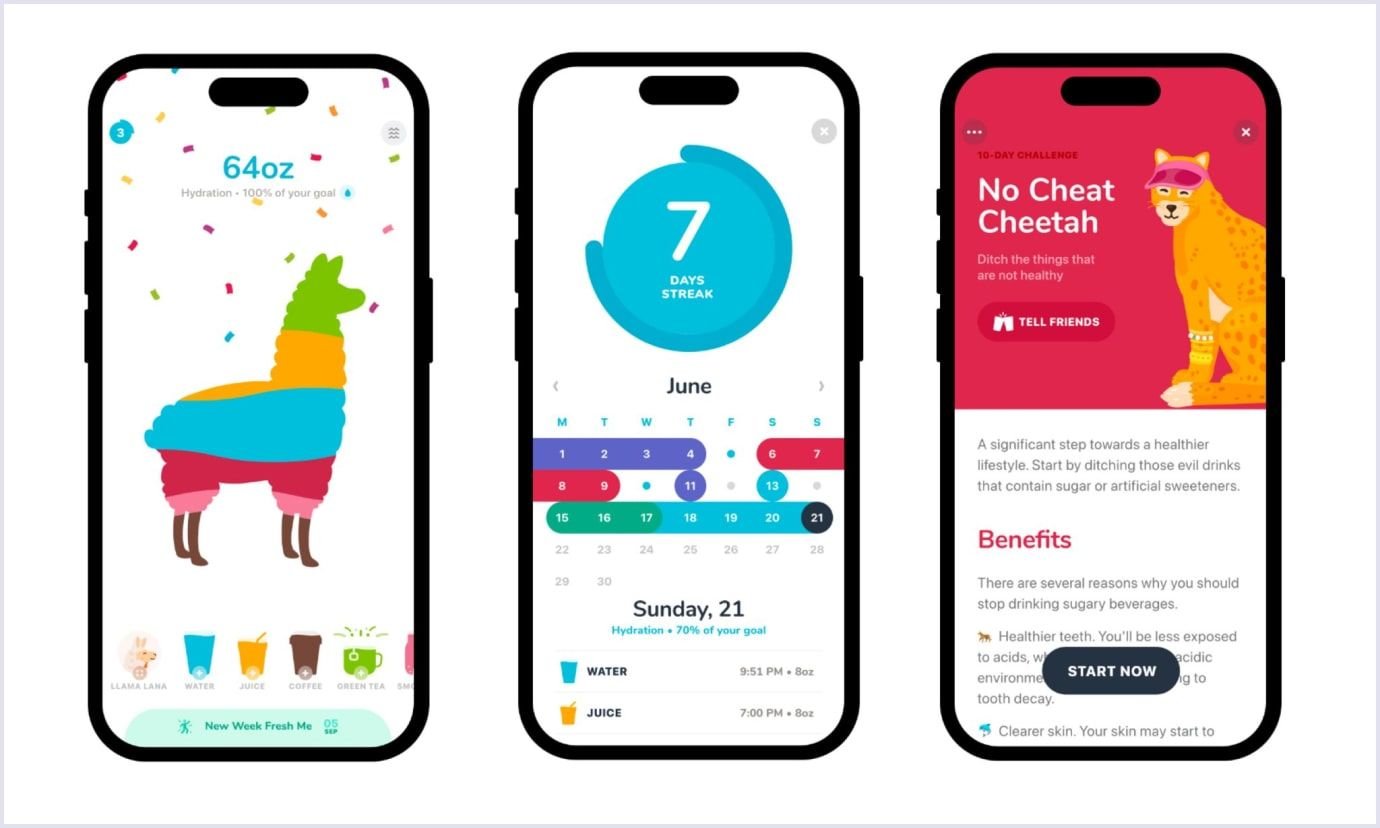
You may also like: Mental Health App Development: Types, Cost, and Process
Forest
Next on our list is a productivity app called Forest. It allows users to set up certain time frames to focus on tasks. Although it sounds simple, the app possesses a very creative gamified concept, which led it to the top of the productivity apps category.
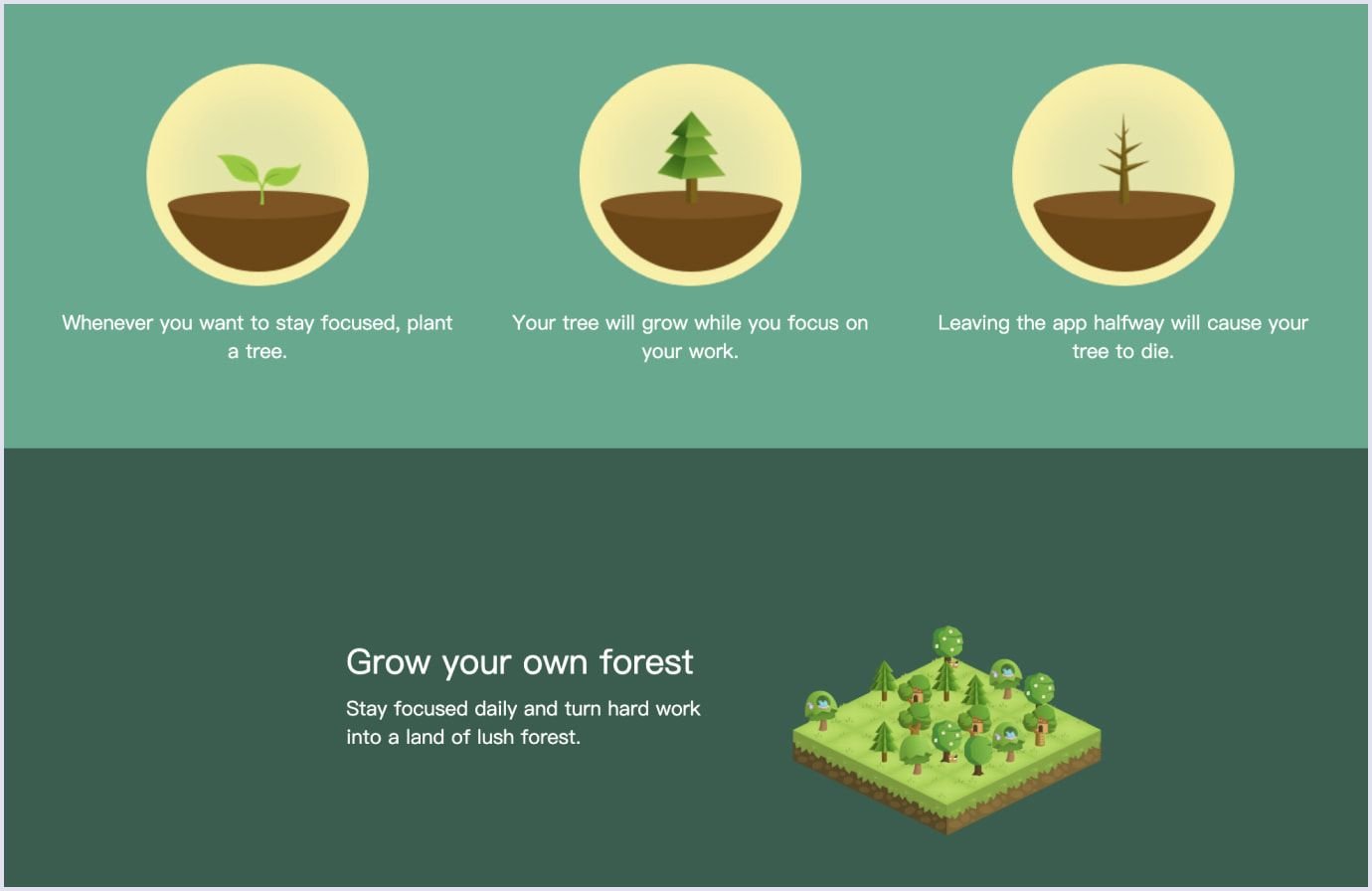
Once users start a focus mode in the app, they set a timeframe for which they want to work, and then the app plants a tree in a gamified manner. As the user continues working on the task, the tree grows and prospers.
Later, if the work time hasn’t been interrupted, the tree is successfully grown, and users can create their own virtual forest resembling the number of their successful focus times.
On the other hand, if the focus mode is interrupted, the tree starts rotting and dies.
As a result, such simple logic creates a competitive environment for users, motivating them to focus on their tasks, achieve rewards in the form of new trees, and simply celebrate their progress.
Gamification in finance apps
On the one hand, finances is an extremely serious niche where people manage their money, investments, etc. However, they might appear tedious to some people. Hence, companies started to add gamification apps in business operations, which don’t interrupt the working processes but add more joy, interest, and curiosity. Let’s take a look at a few examples.
Monobank
This Ukrainian virtual bank stands out a lot compared to other banking apps. While Monobank offers regular banking app features, it also emphasizes extremely fast and smooth performance.
Speaking of gamification, this app offers achievements and lots of them. For instance, users can acquire several by purchasing a number of movie tickets, filling up the car, or making a hundred payments with Apple or Google Pay.
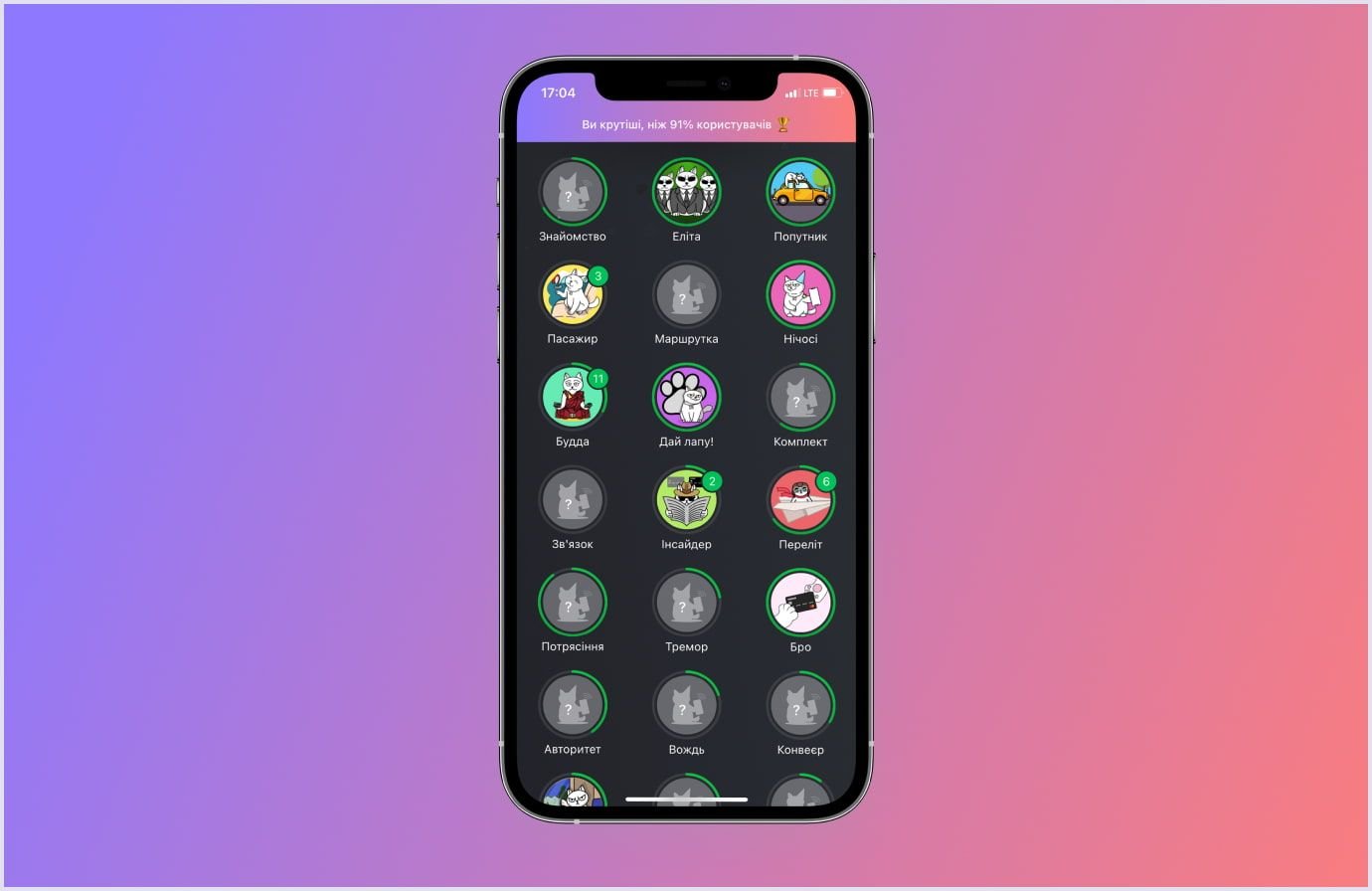
In other words, there are numerous ways people can spend money these days, and the app took advantage of it by adding those achievements. When this feature first appeared, people who gained certain achievements could upgrade their credit card tier, and some even won a car.
Moreover, Monobank could be the one and the only banking app that has real built-in games. They are completely hidden in the interface, but curious users can easily find them.
The first one is hidden behind the reload page indicator. When the user pulls to refresh the page, they need to click the reload indicator, and the interface will change with an analog of the “Space Invaders” game.
The other one is hidden in the savings tab. If the user holds the icon for a certain time, the interface once again changes but with the classic “Snake” game.
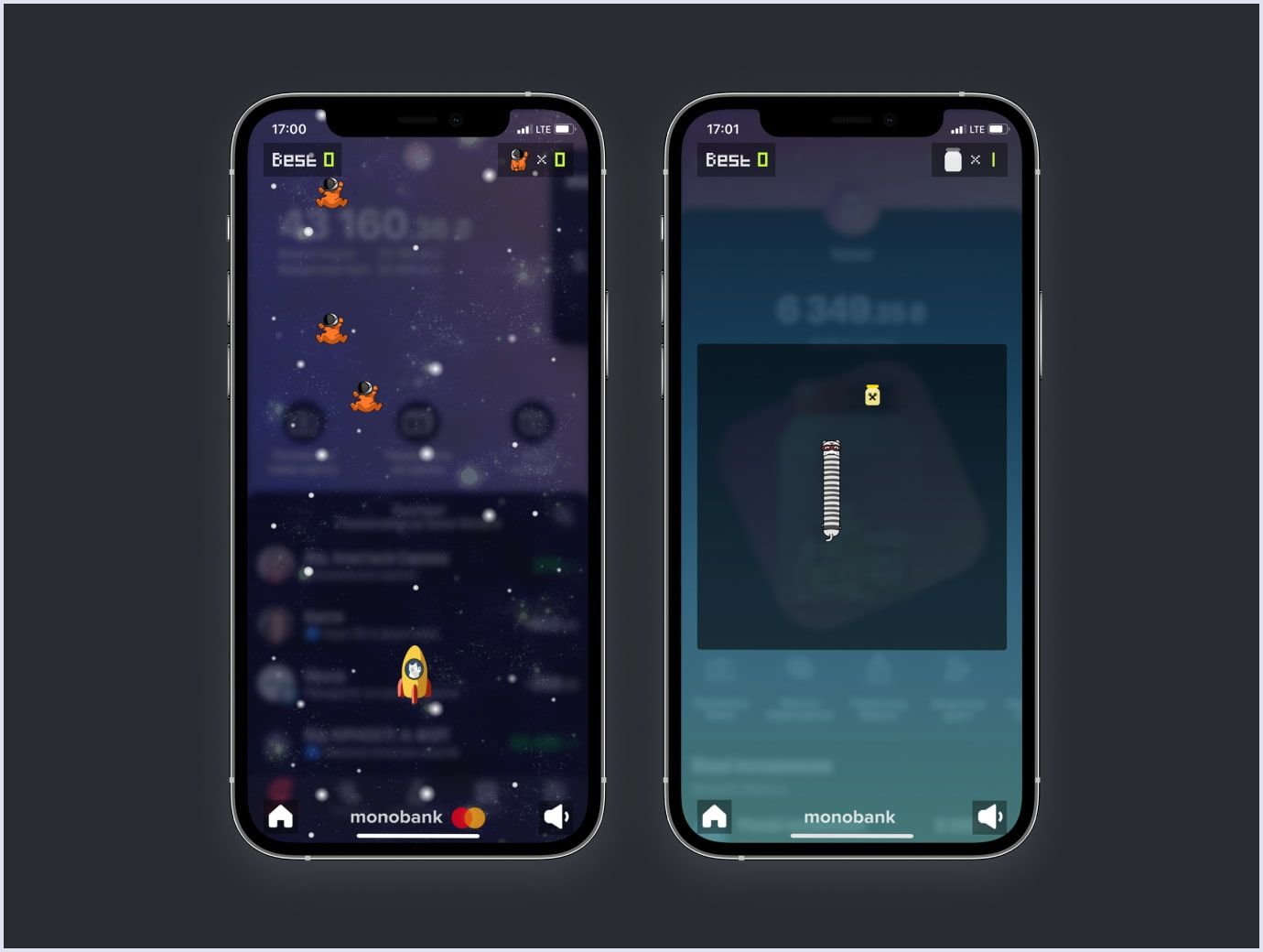
Fortune City
This app is a gamified expense tracker that brings it to a new level. It doesn’t simply add gaming mechanics to the app. Instead, there’s a whole game combined with the expense tracking routine.
With Fortune City, users can track their spending, and, in return, they can build their city. What is even more fascinating is that the app analyzes what users are actually spending their money on. If, for instance, they regularly use public transport, the city gets populated with bus stops, metro stations, etc. More entertainment establishments appear in the city if they spend more on dining outside, movies, and shopping.
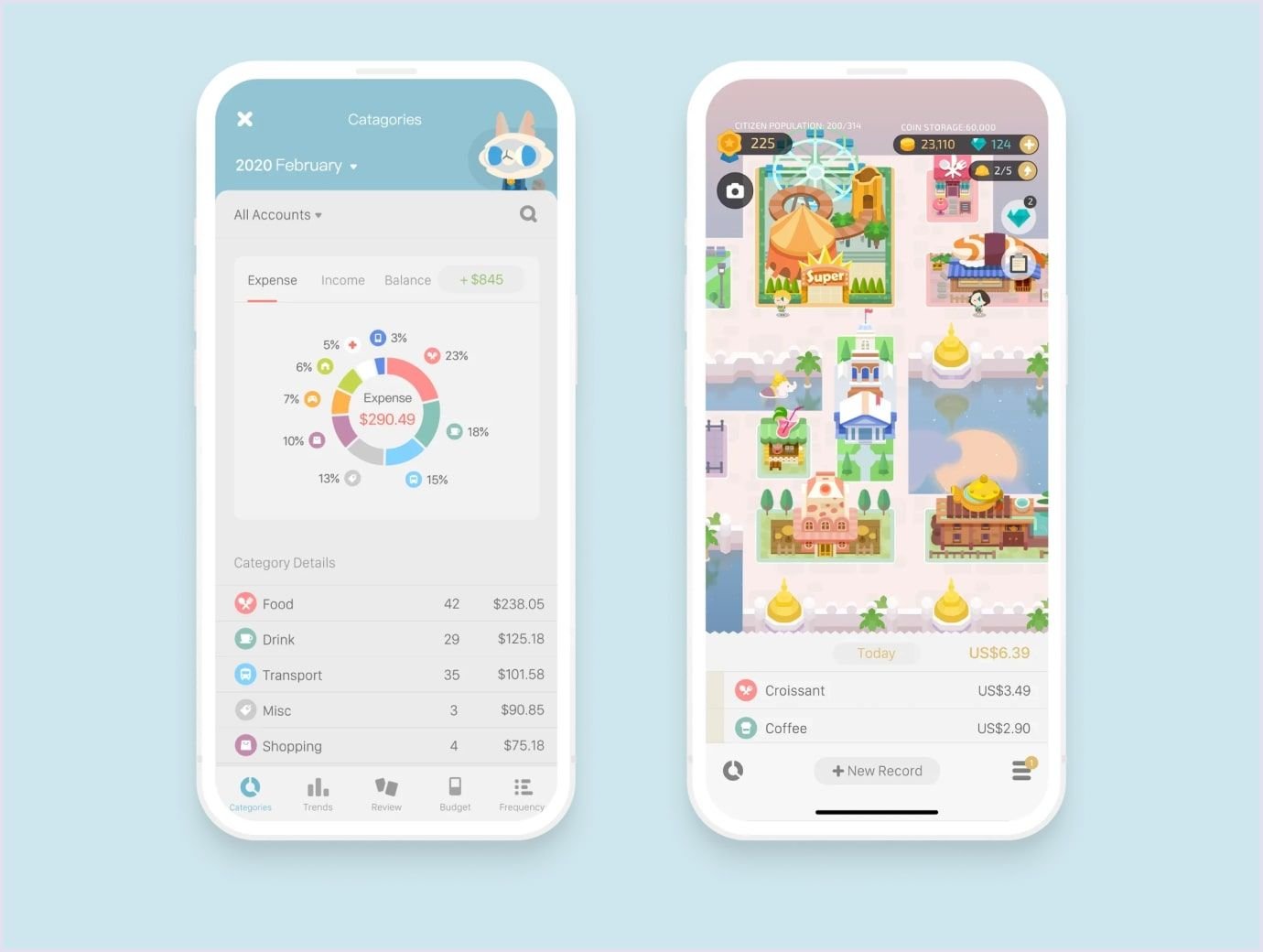
Additionally, the Fortune City app also has other gaming elements. From the images above, you can see that the game also grants users in-game currency, such as coins and diamonds, which people can later spend on something.
Moreover, the app also has a leaderboard, another popular gamification element. As users connect with their friends, they can compete who has more citizens, a bigger city, or a more prosperous one.
Gamification in fitness apps
Lastly, let’s talk about fitness apps and why gamification has a place in them. As everyone knows, sport requires effort, inspiration, and self-discipline. Hence, gamified elements can be of great help to foster those feelings and qualities. One of the most popular forms of gamification in fitness apps is leaderboards, which you will see in both examples.
Strava
This app’s users count in millions, if not dozens of millions. Strava is a fitness app that allows users to track their outdoor activities, such as swimming, bike riding, running, and more.
Strava utilizes modern-day technologies such as heart rate tracking, GPS, and many other metrics smartwatches and smartphones can get from users.
Speaking of gamification, Strava has Segments. These are user-made routes each user can try and compete on speed with others. Moreover, leaderboards are dedicated to each route, making the competition even more engaging.
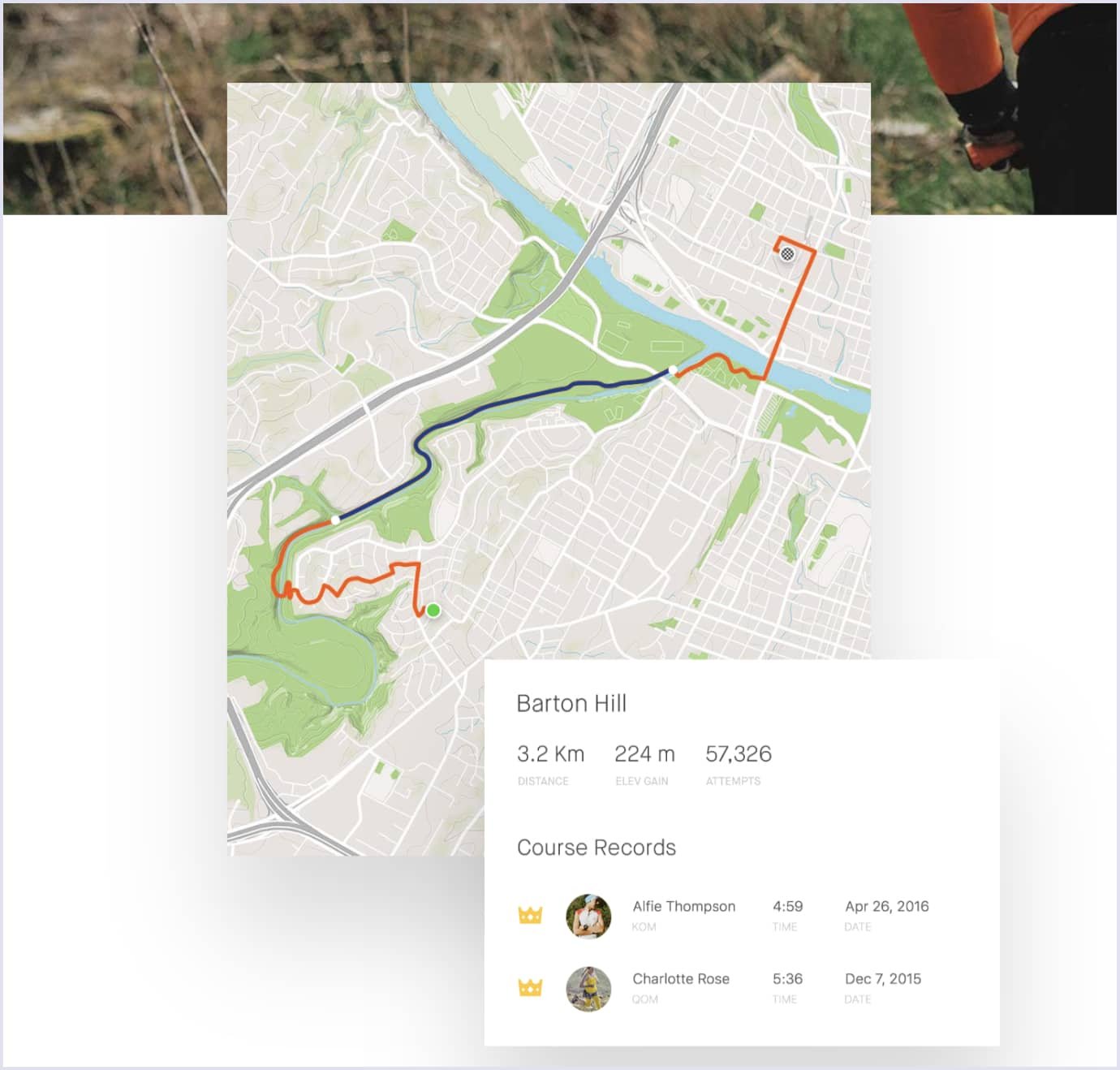
Read also: How to Create a Fitness App: Codica's Expertise
Impact
Not a long time ago, the Codica team built a solid personal training software. Impact Personal Training is a progressive web application (PWA) that resembles the functionality of the regular mobile app but with a few solid advantages.
PWAs can be installed right from the browser and weigh less than regular apps. Moreover, they are fast and performant, which makes them available to a bigger range of users.
Impact itself is a personal training fitness app that has all the vital functionality to help people stay fit, follow nutrition programs, and track their progress. Although Impact is built without a certain focus on gamification, it still possesses room for inspiring and motivating people to keep up with their goals.
For instance, users can set up their personal training plan, outline desired goals, and work their way to achieve them.
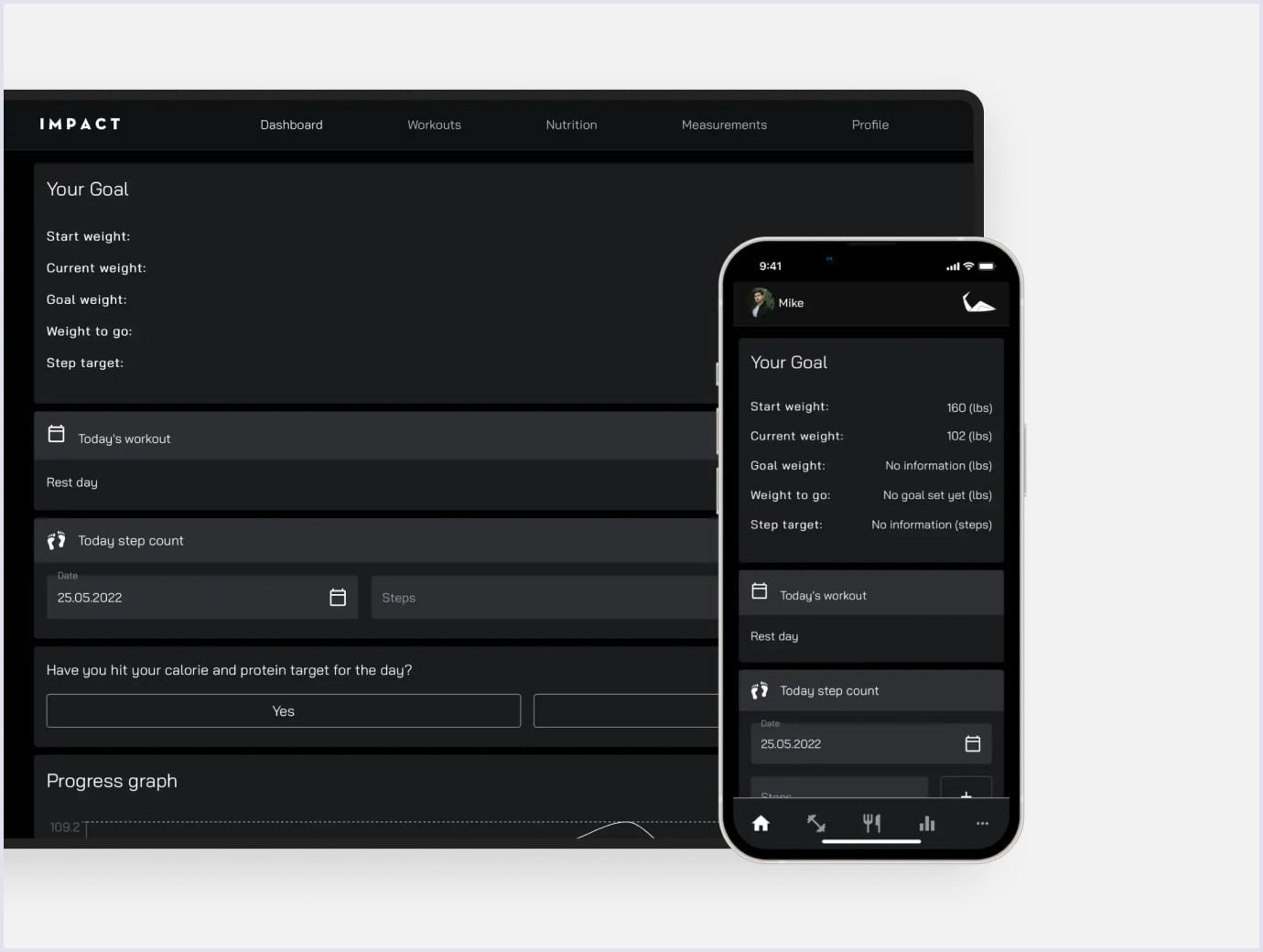
Seven
The name of this app advocates seven-minute workouts, which are a great technique to stay fit during busy days. Seven is a simple fitness app with exercise sets, tracking functionality, and so on.
But when the gamification comes into play, things are getting really interesting! First of all, the app has streaks users can mark for each completed training day. It also has interactive 3D guides, which may not seem like from the gaming world, but they’re exciting and attractive nonetheless.
Lastly, Seven has events that unite people all over the globe to compete in different categories. Later on, users can comment on others’ progress, choose similar workouts with their friends and family, and even earn and share achievements they get.

Simply put, Seven is an engaging fitness app, but with the help of gaming elements, it looks exciting at a glance, provides room for competitiveness, and motivates people to keep using it.
Wrapping up
To sum everything up, gamification in mobile apps is a highly effective strategy for engaging users and enhancing their experience. Moreover, as you can see from the examples, such elements can be added to any app to make it more positive, motivate users, boost productivity, and foster a sense of accomplishment.
In this matter, our custom software development services can be of utmost help. We know how to strike the right balance between productivity and fun to revolutionize app experiences. For example, in our portfolio, you can observe many different products we built, each driving user satisfaction and loyalty to new heights. Contact us to discuss your great app idea.

